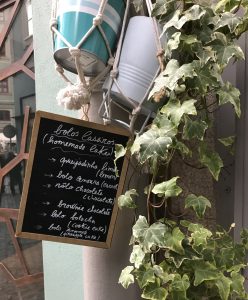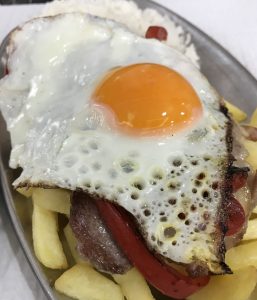KN, p. 290 “Portuguese Food Adventure”
The best part of any trip for a food enthusiast is the wonderful taste treats encountered along the way. The beach might be fun, the mountains may be spectacular, but if we can share the views with friends over a great meal, the memories will stay with us for a very long time.
We spent our recent trip to Portugal in Porto and Braga, (in the northern region, about four/ five hours north of Lisbon). We discovered that northern inland Portugal eateries focused on cod, the national fish of Portugal, as a menu choice. Fried, poached, grilled, broiled, mashed – with different sauces everywhere. The coastal towns have a larger sampling of the seas, but the islands of the Azores deliver the greatest variety I have ever eaten – including fish I had never heard of before. Dourado (a type of bream) and robalo (a type of sea bass) can be found in more expensive restaurants, as well as at lunch counters near the ocean.
Since the bigger Portuguese cities are tourist destinations for an international crowd, small restaurants and specialty lunch places are tucked around the edges of central plazas. They offer freshly cooked food – a big departure from American chains.
Enjoyed as a ‘fast-food’ all over the EuroZone, Doner Kebab is basically shaved meat (lamb, veal, or chicken) served on a hamburger roll or in a takeout box on top of fresh vegetables. The meat is stacked and cooked on a metal rod and often displayed in the front window of the restaurant. A large shaver is used to slice the meat quite thin.


The Doner Kebab lunch in a Porto sandwich shop near the train station was made with chicken. Beneath the chicken in the photo is shredded lettuce and tomato. The sauce is a garlicky, mayo type sauce similar to Tzatziki.
Lots of lunch menus include beef, chicken, or fish served with an egg on top. We ate this dish (steak and peppers with fries under the egg) at a diner-type place in Porto frequented by the locals – a great venue for comfort food served quickly to people from the neighborhood businesses on their lunch hour.
One welcome change we found on this trip to northern Portugal was that almost all the restaurants now have some version of a tossed salad on the menu, as well as vegetables listed as side dishes. The vegetables are well-seasoned to complement the main dishes. We have yet to eat at a place with bland food, so bring your taste buds.
Part of the foreign travel adventure is that our American stand-by favorites are frequently reimagined (or deconstructed) to reflect the local chef’s interpretation. The dinner menu at a lovely restaurant in Braga promised a bacon, lettuce, and tomato sandwich. This is what was served – layers of Canadian style bacon, bread, and sliced tomato, all sitting in a tomato soup with an egg on top. Delicious, spicy, and oh so filling, but not at all what a traveler from the U.S. would expect for a BLT.
Another night, we wandered into a vegetarian restaurant that advertised all-you-can-eat with a price tag of about $12.00 for each of us. We doubted that we could stuff ourselves on ‘just veggies,’ but wow, were we wrong. Large platters filled the banquet tables with beautifully arranged appetizer sized vegetable concoctions. One notable item we might try to make at home was sliced, grilled sweet potato rounds, with a dollop of zesty hummus on top. Another platter held small stuffed mushroom caps filled with a pesto mixture. Yum!
As travel opens up around the world, be prepared to be surprised and delighted by the many new choices of cuisine. There are tourist traps out there that charge too much for the food you are served, but many are quite reasonably priced. Most places have menus near the doorway so you can be prepared before walking in (or away). We have found gems tucked behind the famous spots, and lousy food when a renowned chef has a bad day, but we’ve had tons more great food than ‘eh.’
It’s all an adventure and you’ll come back with great stories to share. Plus, some of the places we visited were perfect settings for murder mysteries, with subdued lighting and centuries-old architecture, so what’s not to like?
KN, p. 290 “Portuguese Food Adventure” Read More »







